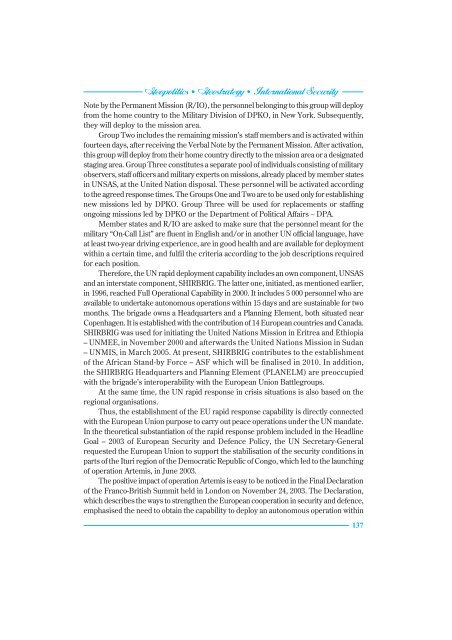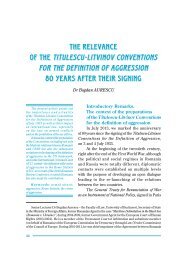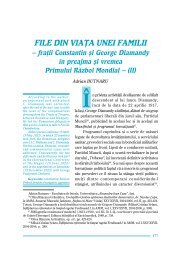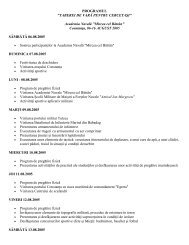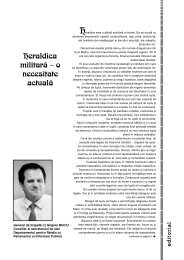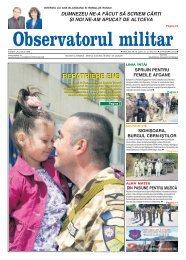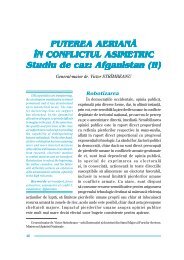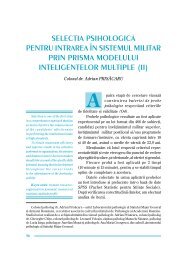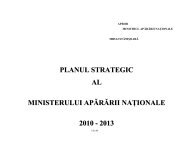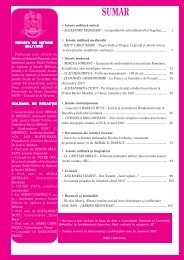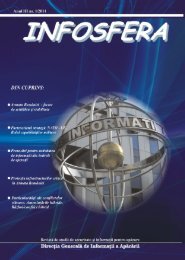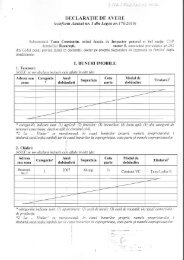Romanian Military Thinking
Romanian Military Thinking
Romanian Military Thinking
Create successful ePaper yourself
Turn your PDF publications into a flip-book with our unique Google optimized e-Paper software.
Geopolitics • Geostrategy • International Security<br />
Note by the Permanent Mission (R/IO), the personnel belonging to this group will deploy<br />
from the home country to the <strong>Military</strong> Division of DPKO, in New York. Subsequently,<br />
they will deploy to the mission area.<br />
Group Two includes the remaining mission’s staff members and is activated within<br />
fourteen days, after receiving the Verbal Note by the Permanent Mission. After activation,<br />
this group will deploy from their home country directly to the mission area or a designated<br />
staging area. Group Three constitutes a separate pool of individuals consisting of military<br />
observers, staff officers and military experts on missions, already placed by member states<br />
in UNSAS, at the United Nation disposal. These personnel will be activated according<br />
to the agreed response times. The Groups One and Two are to be used only for establishing<br />
new missions led by DPKO. Group Three will be used for replacements or staffing<br />
ongoing missions led by DPKO or the Department of Political Affairs ~ DPA.<br />
Member states and R/IO are asked to make sure that the personnel meant for the<br />
military “On-Call List” are fluent in English and/or in another UN official language, have<br />
at least two-year driving experience, are in good health and are available for deployment<br />
within a certain time, and fulfil the criteria according to the job descriptions required<br />
for each position.<br />
Therefore, the UN rapid deployment capability includes an own component, UNSAS<br />
and an interstate component, SHIRBRIG. The latter one, initiated, as mentioned earlier,<br />
in 1996, reached Full Operational Capability in 2000. It includes 5 000 personnel who are<br />
available to undertake autonomous operations within 15 days and are sustainable for two<br />
months. The brigade owns a Headquarters and a Planning Element, both situated near<br />
Copenhagen. It is established with the contribution of 14 European countries and Canada.<br />
SHIRBRIG was used for initiating the United Nations Mission in Eritrea and Ethiopia<br />
– UNMEE, in November 2000 and afterwards the United Nations Mission in Sudan<br />
– UNMIS, in March 2005. At present, SHIRBRIG contributes to the establishment<br />
of the African Stand-by Force – ASF which will be finalised in 2010. In addition,<br />
the SHIRBRIG Headquarters and Planning Element (PLANELM) are preoccupied<br />
with the brigade’s interoperability with the European Union Battlegroups.<br />
At the same time, the UN rapid response in crisis situations is also based on the<br />
regional organisations.<br />
Thus, the establishment of the EU rapid response capability is directly connected<br />
with the European Union purpose to carry out peace operations under the UN mandate.<br />
In the theoretical substantiation of the rapid response problem included in the Headline<br />
Goal – 2003 of European Security and Defence Policy, the UN Secretary-General<br />
requested the European Union to support the stabilisation of the security conditions in<br />
parts of the Ituri region of the Democratic Republic of Congo, which led to the launching<br />
of operation Artemis, in June 2003.<br />
The positive impact of operation Artemis is easy to be noticed in the Final Declaration<br />
of the Franco-British Summit held in London on November 24, 2003. The Declaration,<br />
which describes the ways to strengthen the European cooperation in security and defence,<br />
emphasised the need to obtain the capability to deploy an autonomous operation within<br />
137


